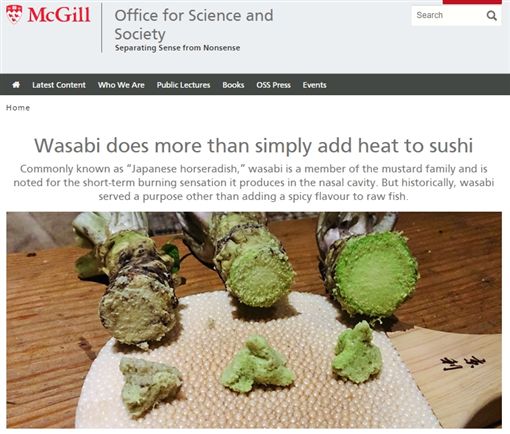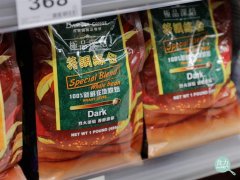What's the best thing to eat with mustard? There was a big difference between horseradish, mustard and horseradish!
Eating Japanese food, especially sashimi, is bound to touch "Washami". The stereotype is said to help sterilize and protect health, but some experts jump out and say, "you've all been deceived!" The real horseradish does inhibit bacteria, but the Japanese restaurant in the square doesn't give it at all, but horseradish that tastes very similar to mustard!

How long have you been fooled by fake Shami? There was a big difference between horseradish, mustard and horseradish!
▲ horseradish, mustard and horseradish? The Forestry Experimental Institute of the Council of Agriculture specially issued a clarification of the food safety dispute on its official website. (photo / photo taken from the official website of the Council of Agriculture)
The Forestry Laboratory of the Council of Agriculture also posted a clarification on the official website that horseradish, mustard and horseradish are indeed very different! According to the clarifications and experts of the Forest Research Institute, wasabi (scientific name Wasabia japonica) is a kind of plant belonging to Cruciferae, also known as "mountain horseradish", also known as: Washami (Washami, due to different translation), horseradish, horseradish, is a kind of rare spicy plant vegetable growing in the shade of alpine mountain area at an altitude of 1300 ~ 2500 meters, with a strong taste. It is the rhizome that is used to eat.
How long have you been fooled by fake Shami? There was a big difference between horseradish, mustard and horseradish!
▼▲ really "wow Shami" horseradish garden director like this! Generally, it takes 3 years for horseradish to serve as seasoning, and good ones take 5 years or more. (photo / courtesy of horseradish talent Cai Zhongliang)
How long have you been fooled by fake Shami? There was a big difference between horseradish, mustard and horseradish!
Cai Zhongliang, who has studied and planted Washami for 31 years, is currently the largest horseradish in China. He said that wasabi contains isothiocyanate, which can inhibit bacteria. International journal McGill (Joe Schwarcz PhD | 20 Mar 2017) even pointed out that horseradish has antimicrobial properties. Among them, 6-methyl sulfinyl hexyl isothiocyanate (6-methylsulfinylhexyl isothiocyanate) has been identified as an effective antimicrobial agent for bacteria such as Escherichia coli and Staphylococcus aureus. In Japan, its extract is even used as a preservative for lunch bags. Cai Zhongliang said that horseradish is divided into green, red and purple peduncles, and the purple horseradish has the highest medicinal value.
How long have you been fooled by fake Shami? There was a big difference between horseradish, mustard and horseradish!
▲ international journal McGill also pointed out that "horseradish" has antimicrobial properties, in which 6-methylsulfinylhexyl isothiocyanate is recognized as an effective antimicrobial agent for bacteria such as Escherichia coli and Staphylococcus aureus. (photo / photo taken from McGill International Journal)
Real horseradish root has a certain sweet taste, which is different from that of mustard and horseradish substitutes, but once dried, the sweetness and spicy taste will disappear, so real horseradish is not suitable for processing into powdered products. The vast majority of the so-called "horseradish" on the market are horseradish, in paste and dry powder. The paste is usually filled with tube-shaped tubes of toothpaste, and powdered products are bagged and canned, which can be made with water and boiled paste, mostly made from Armoracia rusticana, a cruciferous plant like radish, and green food pigments.
How long have you been fooled by fake Shami? There was a big difference between horseradish, mustard and horseradish!
▼▲ really "wow Shami" looks like this! The market price of a top horseradish with a size of 5L and a length of 6cm is 15,000 yuan per kilogram, which is equivalent to 1500 yuan for 100g. The following picture shows the branches and leaves of purple horseradish. (photo / courtesy of horseradish talent Cai Zhongliang)
However, some Japanese-made paste products contain real horseradish, and there will be differences in words on the packaging. For example, "Japanese horseradish" (using real horseradish) contains 50% or more horseradish, while "Japanese horseradish" (adding real horseradish) contains less than 50% horseradish. But almost all sushi restaurants in the United States or China, and some sushi restaurants in Japan, use imitation horseradish because real horseradish is very expensive. Cai Zhongliang said that the market price of a good purple horseradish can reach 15,000 yuan per kilogram, which is equivalent to 1500 yuan for 100g.
▼▲ horseradish branch and leaf appearance, we eat is the root and stem part. (photo / courtesy of horseradish talent Cai Zhongliang)
How long have you been fooled by fake Shami? There was a big difference between horseradish, mustard and horseradish!
As for wasabi, Lin said that wasabi is sometimes mistakenly referred to as wasabi in Chinese, but in fact wasabi is produced by mustard seeds and has nothing to do with wasabi. The English names of wasabi and Mustard are also different. Horseradish is Wasabi in English and mustard is Mustard in English, but both are irritating sauces. Mustard, also known as mustard, mustard, or mustard, mustard is a kind of mustard thick, with a strong taste, made from the seeds of mustard vegetables ground and mixed with water, vinegar or alcohol. sometimes spices or other additives are added to enhance flavor or color, such as turmeric. The seeds of three kinds of mustard vegetables, including white or yellow mustard seeds, brown mustard seeds or Indian mustard, and black mustard seeds can be used to make mustard, that is, mustard seeds are ground into powder and processed into paste, that is, mustard, for seasoning.
How long have you been fooled by fake Shami? There was a big difference between horseradish, mustard and horseradish!
▲ this is horseradish, also known as "green mustard" or "Japanese mustard", and is commonly used as a seasoning for imitation horseradish. (photo / courtesy of horseradish talent Cai Zhongliang)
Horseradish (scientific name: Armoracia rusticana), also known as Western Shanyu, horse radish, mountain radish, powder wasabi, is a perennial perennial root hardy plant of Cruciferae, which can be used as a vegetable and has the spicy taste of stimulating paranasal sinuses. The substitute for horseradish is often called "green mustard" or "Japanese mustard" because horseradish smells or tastes similar to mustard, but in fact, horseradish and horseradish belong to different genera and have nothing to do with mustard. General spicy eradication is not only used as seasoning for roast beef and other dishes in European countries, but also as a seasoning material for imitation horseradish.
- Prev

The agricultural chemical giant Bayer has made a huge loss in setting aside 84.3 billion for Monsanto, a seed company.
German chemical giant Bayer announced its third-quarter results, showing that the group paid a heavy price for the acquisition of American seed supplier Monsanto, resulting in a quarterly loss of 9.4 billion euros (HK $85.764 billion) before tax and interest, and a net loss of 2.7 billion euros during the period.
- Next

Why is it claimed that Arabica beans can be sold at a high price? What are the benefits of coffee adulteration?
As early as a few years ago, 100% Arabica suddenly appeared, in fact, this situation is for commercial coffee beans, while in the boutique coffee industry, 95% of the boutique coffee beans are Arabica coffee beans, because Shangchao Coffee is originally.
Related
- A one-day flower show brings 130 million yuan in orders! Nanhai, this Phalaenopsis exhibition is amazing
- What do the flower language and meaning of Lutheran tree mean? Precautions for planting Lutheran tree
- Encounter Chaoshan Kongfu tea, not without this cup of Phoenix single clump
- The durian market in Vietnam and Thailand is flooded. The price of imported durian has plummeted by 30-40% in a month.
- Shanghai solved the problem of local vegetable supply by planting 80,000 mu of green leafy vegetables.
- Wageningen University has become the best agricultural university in the world for the seventh time in a row.
- The strongest export season of South African grapes is full of challenges, with exports to Russia falling sharply by 21%.
- Sri Lanka is on the verge of bankruptcy, "Tea for debt" Organic Agriculture Revolution aggravates the Food crisis?
- Turning waste into earthworm manure and worm manure into organic fertilizer-A new choice for auxiliary farming
- Organic rice growers shoulder the responsibility of nurturing agricultural talents! Yinchuan Sustainable Farm with Organic Life Camp

